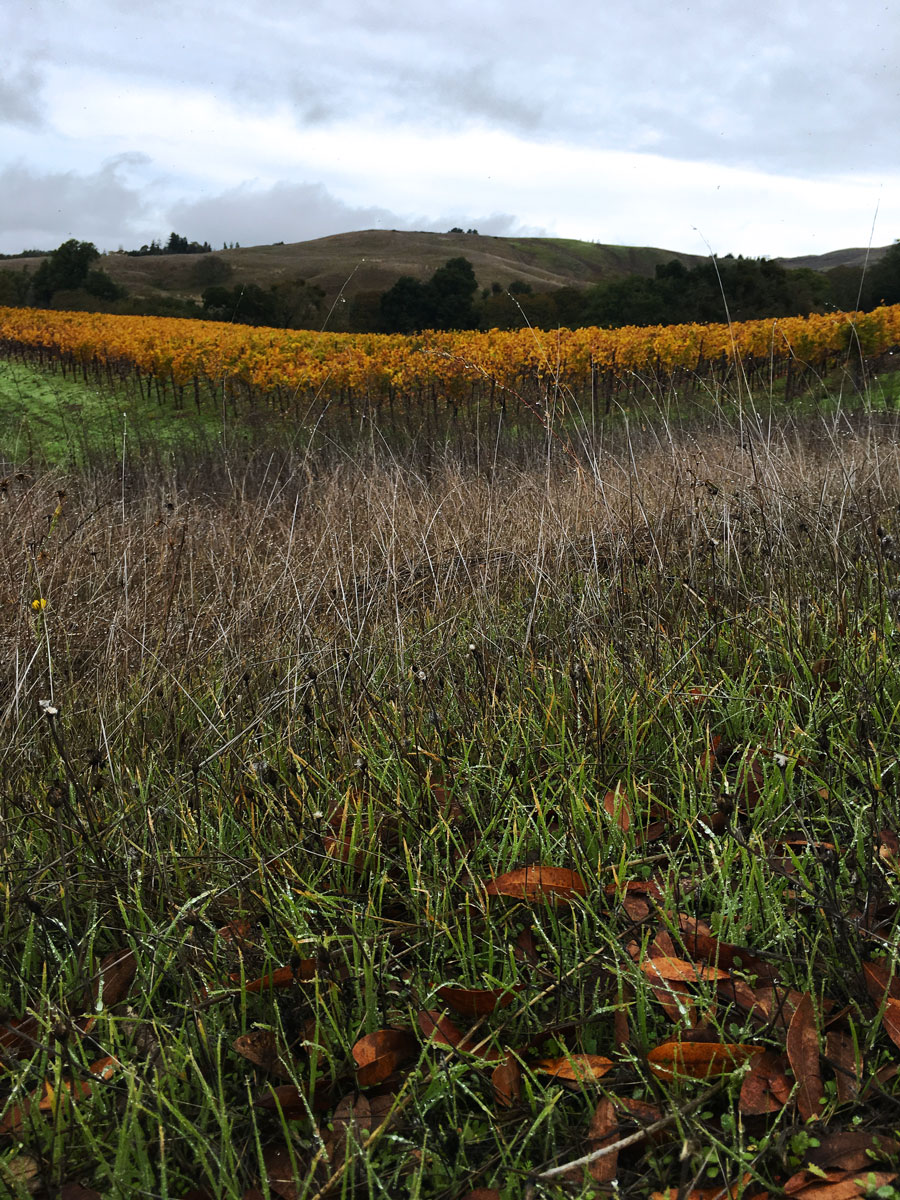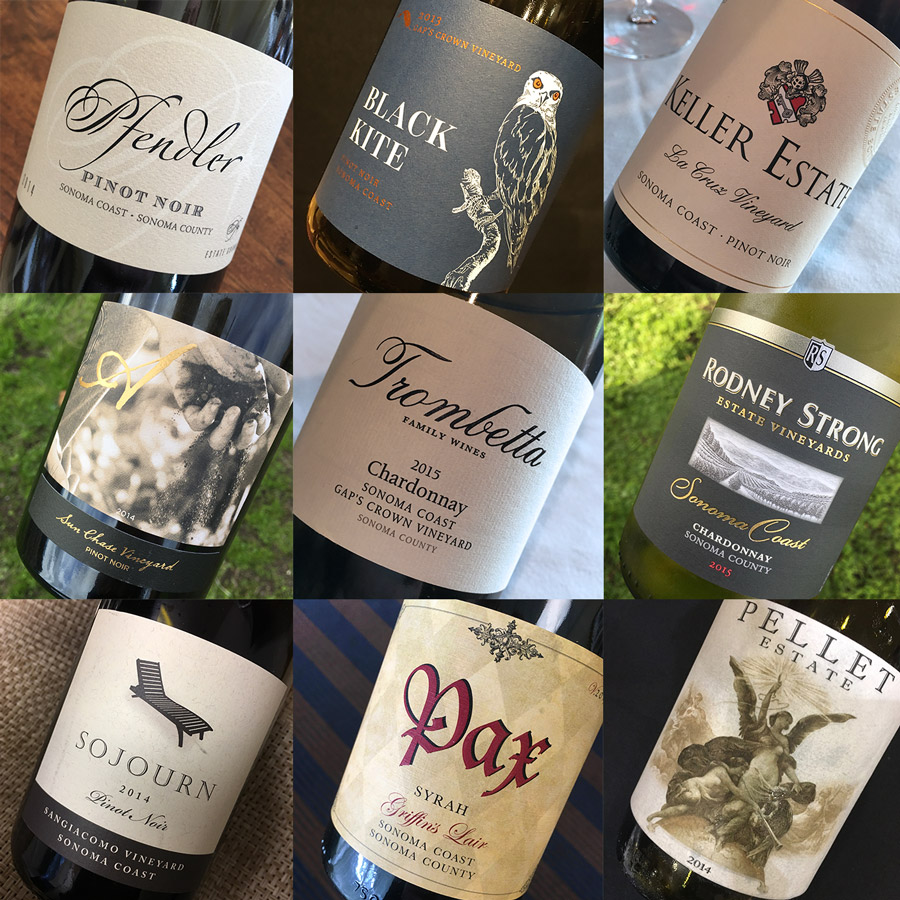What is a place? What are its boundaries? How do we know, and who decides? These are essential questions of terroir. When we say wines here are like this, wines there are like that, the definitions start with soil and sun but quickly expand, because people—messy, complicated people—make the wine.
In March of 2014 a group of winegrowers in California’s Petaluma region, in southwestern Sonoma County, began an effort to name their place. In February 2015 they submitted a formal AVA petition. The arguments were solid, and everyone thought this place-naming would be approved swiftly, finito. But the arcane machinery of bureaucracy got clogged by administrative regime change, resulting in months of delay. Finally, on December 7, 2017, the Alcohol and Tobacco Tax and Trade Bureau coughed forth a verdict, and the newest American Viticultural Area was born: Petaluma Gap.

A view of fields and fog from Pfendler Estate, on Sonoma Mountain
Formerly, wines here had to bear the appellation Sonoma Coast—and that was the problem. Sonoma Coast is sprawling and diverse, over half a million acres stretching from Gualala, at the coast on the Mendocino County line, south to Bodega Bay and then inland across the city of Petaluma to San Pablo Bay, east of Marin. It’s like lumping together Champagne, Burgundy, and Alsace because they all happen to be on that side of France.
The Petaluma corner of Sonoma feels like farm country first, wine country second. The drive north along Lakeville Highway is marked by scruffy pastures dotted with sheep and cows, rotting machinery, a punctuation of barn, tenuously vertical. People here describe themselves as scrappy, creative, improvisational. Not glam, and maybe even anti-glam. Winegrowers here wanted to put something more specific than “Sonoma Coast” on their labels. They wanted their own identity.

Petaluma Gap is a short drive from San Francisco, but this is farm country
Truthfully, the Petaluma Gap’s uniqueness as a terroir isn’t controversial. I visited over a dozen growers on a tour of the Gap, a guest of the winegrowers’ alliance, and heard a ringing chorus of consensus about what makes the Gap, and its wines, unique.
First: “It’s about the wind,” said Rickey Trombetta Stancliff, C.E.O. of Trombetta Family Wines and president of the board of the Petaluma Gap Winegrowers Alliance. An insistent zephyr washes this terrain, erupting periodically in gusts and spikes. The wind begins at the coast, sluices east across the landscape, and empties finally into San Pablo Bay. “The winds from the ocean flow through this area,” said Ana Keller, of Keller Estate. “The ocean comes to us.”

When the fog clears, Rodney Strong’s Blue Wing Vineyard has a shimmery view of San Francisco
These marine influences mean it’s also wet and salty in the Gap. Like the wind, soils surged in from the Pacific eons ago, leaving behind clay sediments. Today, land along the slough of the Petaluma River, which cuts the countryside like a bright wet blade, is saturated and brackish.
Mist is defining, too. The Pacific’s fog machine pumps up toward dusk, blanketing the land in a thick layer and tucking it in for the night. But when the day dawns again and the sun begins to warm the inland air, hot thermals rip this fog off the landscape like a magician’s tablecloth.
Finally, it’s cool here, relatively speaking. Not cold, but persistently cool, the wind and moor-like haze conspiring to dampen temperatures. That makes fruit ripen gradually, so that harvest “starts early, but it doesn’t end early,” said Alex Holman, production manager at Keller Estate. Sites with more fog mature more slowly, although the disease pressure is higher (rot loves wet). Fortunately, the drying action of the wind helps protect fruit as it angles toward ripeness.

Gap’s Crown Vineyard is one of Petaluma Gap’s best recognized crus
Unsurprisingly, grapes that tolerate cool temperatures do best here. Pinot Noir is king, Chardonnay is queen, and Syrah is their dark prince. Pinot plantings account for about 75 percent of the Gap’s four thousand vineyard acres, with the remainder split nearly equally between the other two. Only a tiny handful of additional varieties is planted.
Slow ripening in Petaluma Gap vineyards preserves acids and builds interestingness into the fruit. “When you push a grape right to the edge, you get complexity,” said Dan Berger, a Sonoma wine journalist, at a tasting and discussion of Syrah in the Petaluma Gap. The most evocative Syrahs I sampled were rare-meaty with a feral streak, somewhat reminiscent of Côte-Rôtie. Standouts included varietal bottlings from Pax, Arnot-Roberts, and Ramey.
It’s not just deep complexity, but freshness, too, that have become hallmarks of Gap wines. The Chardonnays and Pinot Noirs I tasted were characterized by delicate, pretty flavors and firm acidity, plus tinges of stone and salt. Comparisons with French wines are common, and as I spoke with Gap producers, the word “Burgundian” became a kind of drumbeat. Also “Chablis-like” and—yes—I actually heard someone call Petaluma Gap “The Beaune of America.”

Sun Chase Vineyard
But most producers recognize this is not France and shouldn’t be. “A lot of places try to emulate Burgundy,” said Chase Fields, of Sojourn Cellars. But that’s a mistake, he continued. “Our winemaking is not Burgundian. Our climate is much different. We’re not picking to get 13 percent. There are a lot of hipster wineries who say they’re ‘Burgundian,’ but… we’re not trying to be something we’re not.”
Pfendler Vineyards, whose estate lies from 1,000 to 2,200 feet of elevation on Sonoma Mountain, is emblematic of the elegant, attenuated style. Its plantings above the fog line ripen earlier, while the fog-shrouded lower sites take their time. Pfendler’s production includes silken Chardonnay and Pinot Noir with the tang of wild strawberries, but the wines are not simply floral and gauzy, they also feel deep and serious. “I’m not a sweet person,” Kimberly Pfendler said. “I love savory.”

Until the appellation ruling, Petaluma Gap wines could be labeled only “Sonoma Coast”
Although the region is well known for Pinot Noir, Chardonnay’s success is also firmly established. “Chardonnay is the hidden gem of the Petaluma Gap,” said Alexandre Remy. Lanky and youthful, he is a transplant from France and partner in Atlas Wine Co. We met and tasted together in the Sun Chase Vineyard, planted in 2007, which lies at 1,400 feet above the foggy valley floor. I found the whites linear and saline, offering green apple freshness but also suggestions of ginger, pear, and quince paste. The Pinot Noirs were streaked with raspberries and pink flowers but also delivered dark notes of dusty potpourri and sundried tomato.
Sun Chase is among several Petaluma Gap vineyards that have earned a national reputation. Others include Sangiacomo, Durell, and Griffin’s Lair (especially for its Syrah). One of the most famous is Gap’s Crown Vineyard, first planted in 2002. Rob Harris is vineyard manager, and although the 138-acre site has both Pinot Noir and Chardonnay, “This is a Pinot property,” he said firmly (three quarters of the vines are red). Right now Harris has more suitors than fruit, and Gap’s Crown Pinot fetches a premium price: $10,000 per ton, one winemaker quoted me later.
Demand for all Petaluma Gap fruit is high, and with the new appellation ruling, will surely grow. “This place is going to light up in the next two to three years,” Harris said. “There are a lot of grapevines going into the ground.” And it’s not just the Big Three. Other cool-climate grapes are under active consideration, too. “The big question is, what’s the new variety that isn’t Pinot Noir, Chardonnay, or Syrah?” ventured Holman, of Keller Estate. “Albariño?” (It’s not a bad call.)

Keller Estate planted Chardonnay in 1989 and Pinot Noir ten years later. The winery also grows Syrah.
I asked Rob Harris what affect the Petaluma Gap AVA decision would have on the Gap’s Crown brand. “It’s tricky for us,” he said. “Honestly, we already have a name.” Two dozen wineries source fruit from Gap’s Crown, ranging from big houses like Gary Farrell and Paul Hobbs to small wineries like Fulcrum and Wind Gap, putting the vineyard designate on the label.
“Yes, Gap’s Crown is a cult vineyard,” said Stancliff, who, with her daughter, winemaker Erica Stancliff, sources from this vineyard to produce Pinot with exuberant, exotic florality and Chardonnay that’s concentrated and satiny. But, she said, the Petaluma Gap appellation will also benefit Gap’s Crown—and other vineyards with an established name—because it will underscore the uniqueness of the place. “It’s not going to happen overnight,” she said, “but it’ll start the conversation about why these wines are so distinctive.”
Justin Seidenfeld, winemaker at Rodney Strong, agrees. We were standing in the winery’s Blue Wing Vineyard, in the southernmost reach of the Gap. What was his response to putting “Petaluma Gap” on his labels? “Glee,” he said. “The more information to distinguish my wine from the masses, the better.” We tasted Blue Wing’s spicy, flowery Pinot Noir, grown on the site’s gentle slope above a working dairy farm, plus creamy yet distinctly saline Chardonnay grown on the flatland below. The day was sunny and clear, and I was astonished that we could see San Francisco glimmering in the distance.

Blue Wing Vineyard
Throughout my tour of the Gap I was never without my hat and windbreaker. The wind is so consistent a feature that it was one of the defining characteristics of the AVA petition. Boundaries were drawn according to which vineyards enjoyed (endured?) winds at a minimum of eight miles per hour from March to October. (Some vineyards didn’t make the cut, resulting in a few ruffled feathers.)
Still, wind is a curious choice as a defining characteristic of terroir. Place is about edges, yet wind dishonors edges. Wind is not like a shoreline or mountain ridge, not like altitude, or a stratum of subterranean minerals. It does not cleanly cleave This from That. It does not hesitate to cross lines, to dishonor boundaries.
Yet wind is defining here not just because of what it does to the wines, but also because of what it does to the people who live here, the people who feel it on their skin as they work their vines. Wind has become an ingredient in this recipe for place. “We’re bottling the wind,” said Rickey Stancliff. “That’s what’s in the bottle.”
Many thanks to Terroirist, Wine Business, and Wine Industry Insight for recommending this article to their readers.
I’m grateful to the Petaluma Gap Winegrowers Alliance for sponsoring my travel expenses, and to Damien Wilson, Ph.D., for coordinating my visit. All wines were samples for review.





Informative and a pleasure to read. I could almost hear the wind.
Thank you, David, as always, for reading.